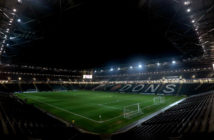
France’s Wendie Renard vies for the ball with New Zealand’s Annalie Longo.
France has one of the longest traceable histories when it comes to women’s soccer. The first female football league in France was established in 1918, by women’s sport pioneer, Alice Milliat, who is best known for her successful efforts to include women’s events in the Olympics. In 1920, her team of Parisians travelled to England to play Lily Parr and the famous Dick Kerr’s Ladies as representatives of France, marking the first international incident of women’s soccer. Sadly, this league was forcibly disbanded after twelve seasons due to a prohibition on women’s soccer. France would not see the like again until 1975, when the ban was lifted and the French federation saw fit to provide a small amount of funding for the sport. It would be over thirty seasons, 2009-2010, until any of the players of the women’s side would see a professional contract; relying on semi-professional contracts, second jobs, family, and/or other support structures to financially support them.
There are currently 12 teams in the league, which is called Divison 1 Féminine. The majority; Bordeaux, Guingamp, Lyon, Marseille, FC Metz, Montpellier, PSG, Rodez, Saint-Étienne, and ASJ Soyaux. Whilst they are affiliated with a men’s side, some, particularly those in smaller cities, may hold more titles and a similar clout. Albi and Juvisy appear to be independent. Out of these sides, Lyon is by far the most successful, holding not only 14 division titles but three champions league titles and 8 coupe de France’s. Club stadium capacities range from Guingamp’s 10,000 to Saint-Étienne’s more modest 1,000. Average attendance sits around 1,000; though numbers as high as 7,000 and as low as 100 have been seen. There’s not a great deal of parity; whilst professional contracts are the standard for some clubs, some still operate with a “play to be paid” system, that only pays players for their time on the pitch. As the story remains in the NWSL, many players take on other jobs or rely on other finances to support their living.
The season runs from September to June,and as many European leagues do, the league runs off promotion relegation, meaning that the bottom three clubs at the end of the regular season are dropped into one of the three respective Division 2 leagues below, whilst the the top team from each of those is promoted. So it goes again, except with the respective four Division 3 leagues. Below that are smaller, regional or local leagues. Only Division 1 is professional, the rest ranging from semi-professional to amateur. There is also an inter-divisional cup competition mandatory for Division 3 clubs and up, though regional sides can choose whether or not to participate. This has been called Coupe de France Féminine since 2011-2012, though it’s been around since 2001-2002 under the name Challenge de France. The top two clubs in Division 1 also qualify for UEFA Champion’s league the following season.
Their national team, whilst having failed to make it to the finals of the olympics, World Cup, or Euros, have been consistent competitors since 2009, and rank 3rd in the FIFA world rankings. It is also all but impossible to discuss the best of women’s club soccer without mentioning Olympique Lyonnais, or Lyon.

Alex Morgan celebrates with Lyonnais teammates in a 2-0 over Wolfsburg March 23, 2017. Photo by Asif Burhan.
Not many Americans have made it over to the French league. Lindsay Horan’s straight from secondary school success with PSG aside, Americans making it across are few and far between. Tobin Heath and Allie Long, also briefly had time at PSG, both finding the net four times in 15 and 12 respective caps. The former missed part of the first Thorns season to do so. Megan Rapinoe played with Lyon in 2013-2014, also missing out on half of the first NWSL season. There are currently five Americans in the league; Tatiana Coleman (Juvisy), Alex Morgan (Lyon), Genessee Daughetee (Montpellier), Madison Krauser (ASJ Soyaux), and Carleigh Williams (FC Metz).
Lyon set their eyes on Alex Morgan shortly before the beginning of last season, and whilst their method of courtship was slightly unconventional, being rather public and seemingly starting with a tweet from their club president, Jean-Michel Aulas, it was seen to fruition when she signed with them on a six month loan. As per statements to the French media, Rapinoe was also key to her decision to sign with them, though she mentioned that it would likely be easier for Morgan than her as the number of English speaking players has increased. Perhaps equal parts effort to improve upon publicity as their output on the pitch, they’ve made no short time of capturing her star power and raising interest. She was featured on the cover of L’Equipe, a nationwide sports specific magazine and was given a ten page spread within it. There will also be a TV series of sorts that follows her at the club. She is far from the only star on the roster; the captains of three national teams, France (Wendie Renard), Germany (Dzsenifer Marozsán) and Sweden (Caroline Seger). Also notable are Ada Hegerberg, a 21 year old who bagged the best Women’s player in Europe award in 2016, and Kadeisha Buchanan, a Canadian defender who would have likely been a first draft pick in the NWSL had she decided to stay.
Whilst the French league lacks extremely in parity from the bottom to its top, it’s still considered to be one of the stronger leagues in Europe, perhaps only bested by Germany. Home to Lyon and PSG, it houses some of the best players in the world, and seems to be seeking to strengthen its position.
Apologies, but no results were found for the requested archive. Perhaps searching will help find a related post. Apologies, but no results were found for the requested archive. Perhaps searching will help find a related post.Culture
Nothing Found
International Women's Soccer
Nothing Found
![Prost International [PINT]](https://prostinternational.com/wp-content/uploads/2021/08/PINTtFontLogoRoboto1536x78.jpg)


